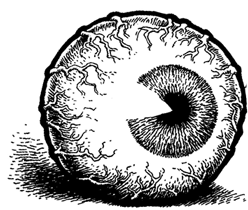EVO Panel
Video from the February 28th panel.


EVO Panel
Video from the February 28th panel.
Coca Crystal
Produced by Sasha von Oldershausen
Coca Crystal wasn't at the East Village Other when it started, but she was one of the few left at the end. When the EVO folded, she started a public access television show which carried on the spirit of the underground paper. It was called "If I Can't Dance You Can Keep Your Revolution." But Coca says her biggest accomplishment may be Gus, her adopted son of 40 years who is physically and mentally handicapped. Despite the hardships, she thinks her devotion to Gus is not unlike her earlier devotion to the EVO.
Claudia Dreifus
Produced by Kait Richmond
Claudia Dreifus was an anomaly at the East Village Other. She didn’t exactly fit the late '60s underground newspaper's image of the so-called “slum goddess." In fact, Claudia wanted to report on the emerging feminist movement. The EVO's male-dominated staff wasn't always receptive, but Dreifus persevered. Now writing for the New York Times, she's one of EVO's biggest success stories.
Charlie Frick
Produced by Kate Yandell
Rock reviewer, layout designer, photographer, fly-on-the-wall — Charlie Frick was each of these things at one point or another during his four years at the East Village Other. But he started out as just a 17-year-old kid from New Jersey who wandered into the underground newspaper's office one day offering to help.
Alex Gross
Produced by Laura Geggel
Reporter Alex Gross began his career in Europe, writing for a newswire that fed underground newspapers around the world. A native New Yorker, he eventually came home and landed at the East Village Other in 1968. Gross was on the front lines of the 60s counterculture, reporting on the Kent State and Jackson State shootings. He also challenged the latent racism within the East Village Other itself. Gross says his journalism career was far from traditional, and he wouldn't have it any other way.
John Jonas Gruen
Produced by Miriam Kramer
From his East Village apartment in 1964, John Jonas Gruen wrote an eye-opening magazine piece about the energy, art and music of his neighborhood. Shortly after his article a group of creative-types launched The East Village Other. The notorious underground newspaper chronicled the neighborhood's late 60s counterculture but flamed out after only a few years. Even now Gruen thinks that the attention he brought to the East Village may have helped hasten its decline.
Steve Kraus
Produced by Nicole Guzzardi
Steve Kraus, age 82, has lived a full life. He's written for newspapers, magazines, and even once hosted a risque cable show in the 70s. But Kraus says his life really started 45 years ago, when he moved to the East Village. He began to notice posters around the neighborhood advertising for a new underground newspaper. It was called The East Village Other, and Kraus never looked back.
Dan Rattiner
Produced by Samantha Balaban
Dan Rattiner is probably best known for Dan’s Papers, the free Hampton's weekly that he founded in 1960. But in 1965 Dan helped launch a paper of a very different sort. The East Village Other was a fledgling underground broadsheet when Rattiner first came aboard. Although he stayed for less than a year, Rattiner’s business savvy pulled the EVO out of obscurity, boosted circulation, and helped start a movement.
Ishmael Reed
Produced by Kelly Slivka
In 1962 the distinguished poet Ishmael Reed moved to New York City from his hometown of Buffalo. Wanting to establish himself as a writer, he started hanging out in the East Village. That’s where he befriended Walter Bowart and ended up as a co-founder of the East Village Other. Reed's tenure at the underground newspaper was rocky and he didn't last long. But one thing remained. The East Village Other's name, which according to Reed, was his idea.
Trina Robbins
Produced by Dana Sherne
Trina Robbins may be best known for her work on the All-American comic book character Wonder Woman in the late 1980s. But she got her start twenty years earlier at the scruffy little alternative newspaper the East Village Other. The EVO was the home of the satirical cartoonist Robert Crumb and became a hotbed of the underground comix movement. Robbins says her career as a cartoonist grew out of her friendship with Walter Bowart, EVO’s publisher, and Allen Katzman, EVO’s editor -- thanks to one long, strange acid trip.
Raeanne Rubenstein
Produced by Von Diaz
Now known for its upscale restaurants and posh boutiques, Manhattan's East Village was once home to Hippies, drug addicts, and the East Village Other. The weekly underground newspaper launched many careers, including that of photographer Raeanne Rubenstein. Rubenstein went on to photograph Andy Warhol and other celebrities before following country music to Nashville. But she never forgot where it all began at the little underground press in the East Village.
Ray Schultz
Produced by Charles Li
The Navy gave Ray Schultz a crew cut and trained him to be a reporter in the early '60s. But by the end of the decade the writer trained his sights back on the government at the East Village Other. Schultz filed dispatches from around the country for an underground newspaper that would leave its mark on all of journalism.
Gil Weingourt
Produced by Jonathan Chang
Gilbert Weingourt is a wanderer. In 1968 he wandered into the East Village Other's office with a camera in his hands but barely any experience. He wandered out almost as quickly, staying for only a year. But in that year he went from being a former military man to one of the chief chroniclers of the '60s counterculture.